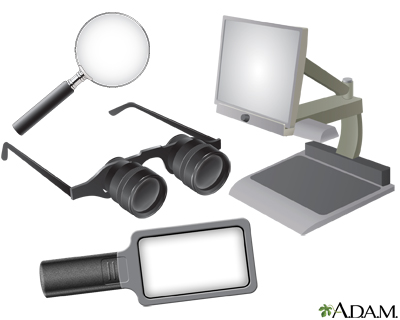Health Library
Blindness and vision loss
Loss of vision; No light perception (NLP); Low vision; Vision loss and blindness
Blindness is a lack of vision. It may also refer to a loss of vision that cannot be corrected with glasses or contact lenses.
- Partial blindness means you have very limited vision.
- Complete blindness means you cannot see anything and do not see light. (Most people who use the term "blindness" mean complete blindness.)
People with vision that is worse than 20/200, even with glasses or contact lenses, are considered legally blind in most states in the United States.
Vision loss refers to the partial or complete loss of vision. This vision loss may happen suddenly or over a period of time.
Some types of vision loss never lead to complete blindness.
Images


I Would Like to Learn About:
Causes
Vision loss has many causes. In the United States, the leading causes are:
- Accidents or injuries to the surface of the eye (chemical burns or sports injuries)
- Diabetes
- Glaucoma
- Macular degeneration
The type of partial vision loss may differ, depending on the cause:
- With cataracts, vision may be cloudy or fuzzy, and bright light may cause glare
- With diabetes, vision may be blurred, there may be shadows or missing areas of vision, and difficulty seeing at night
- With glaucoma, there may be tunnel vision and missing areas of vision
- With macular degeneration, the side vision is normal, but the central vision is slowly lost
Other causes of vision loss include:
- Blocked blood vessels to the retina
- Complications of premature birth (retrolental fibroplasia)
- Complications of eye surgery
- Lazy eye
- Optic neuritis
- Stroke
- Retinitis pigmentosa
- Tumors, such as retinoblastoma and optic nerve glioma
Total blindness (no light perception) is often due to:
- Severe trauma or injury
- Complete retinal detachment
- End-stage glaucoma
- End stage diabetic retinopathy
- Severe internal eye infection (endophthalmitis)
- Vascular occlusion (stroke in the eye)
Home Care
When you have low vision, you may have trouble driving, reading, or doing small tasks such as sewing or making crafts. You can make changes in your home and routines that help you stay safe and independent. Many services will provide you with the training and support you need to live independently, including the use of low vision aids.
When to Contact a Medical Professional
Sudden vision loss is always an emergency, even if you have not completely lost vision. You should never ignore vision loss, thinking it will get better.
Contact an ophthalmologist or go to the emergency room immediately. Most serious forms of vision loss are painless, and the absence of pain in no way diminishes the urgent need to get medical care. Many forms of vision loss only give you a short amount of time to be successfully treated.
What to Expect at Your Office Visit
Your health care provider will do a complete eye exam. The treatment will depend on the cause of the vision loss.
For long-term vision loss, see a low-vision specialist, who can help you learn to care for yourself and live a full life.
References
Cioffi GA, Liebmann JM. Diseases of the visual system. In: Goldman L, Schafer AI, eds. Goldman-Cecil Medicine. 26th ed. Philadelphia, PA: Elsevier; 2020:chap 395.
Colenbrander A, Fletcher DC. Vision rehabilitation. In: Kellerman RD, Rakel DP, eds. Conn's Current Therapy 2022. Philadelphia, PA: Elsevier; 2022:530-535.
Fricke TR, Tahhan N, Resnikoff S, et al, Global prevalence of presbyopia and vision impairment from uncorrected presbyopia: systematic review, meta-analysis, and modelling. Ophthalmology. 2018;125(10):1492-1499. PMID: 29753495 pubmed.ncbi.nlm.nih.gov/29753495/.
Olitsky SE, Marsh JD. Disorders of vision. In: Kliegman RM, St. Geme JW, Blum NJ, Shah SS, Tasker RC, Wilson KM, eds. Nelson Textbook of Pediatrics. 21st ed. Philadelphia, PA: Elsevier; 2020:chap 639.
Raharja A, Whitefield L. Clinical approach to vision loss: a review for general physicians. Clin Med (Lond). 2022;22(2):95-99. PMID: 35304366 pubmed.ncbi.nlm.nih.gov/35304366/.
Rein DB, Wittenborn JS, Zhang P, et al. The economic burden of vision loss and blindness in the United States. Ophthalmology. 2022;129(4):369-378. PMID: 34560128 pubmed.ncbi.nlm.nih.gov/34560128/.
BACK TO TOPReview Date: 8/22/2022
Reviewed By: Franklin W. Lusby, MD, Ophthalmologist, Lusby Vision Institute, La Jolla, CA. Also reviewed by David C. Dugdale, MD, Medical Director, Brenda Conaway, Editorial Director, and the A.D.A.M. Editorial team.
 | A.D.A.M., Inc. is accredited by URAC, for Health Content Provider (www.urac.org). URAC's accreditation program is an independent audit to verify that A.D.A.M. follows rigorous standards of quality and accountability. A.D.A.M. is among the first to achieve this important distinction for online health information and services. Learn more about A.D.A.M.'s editorial policy, editorial process and privacy policy. A.D.A.M. is also a founding member of Hi-Ethics. This site complies with the HONcode standard for trustworthy health information: verify here. |
The information provided herein should not be used during any medical emergency or for the diagnosis or treatment of any medical condition. A licensed medical professional should be consulted for diagnosis and treatment of any and all medical conditions. Links to other sites are provided for information only -- they do not constitute endorsements of those other sites. © 1997- 2023 A.D.A.M., a business unit of Ebix, Inc. Any duplication or distribution of the information contained herein is strictly prohibited.
